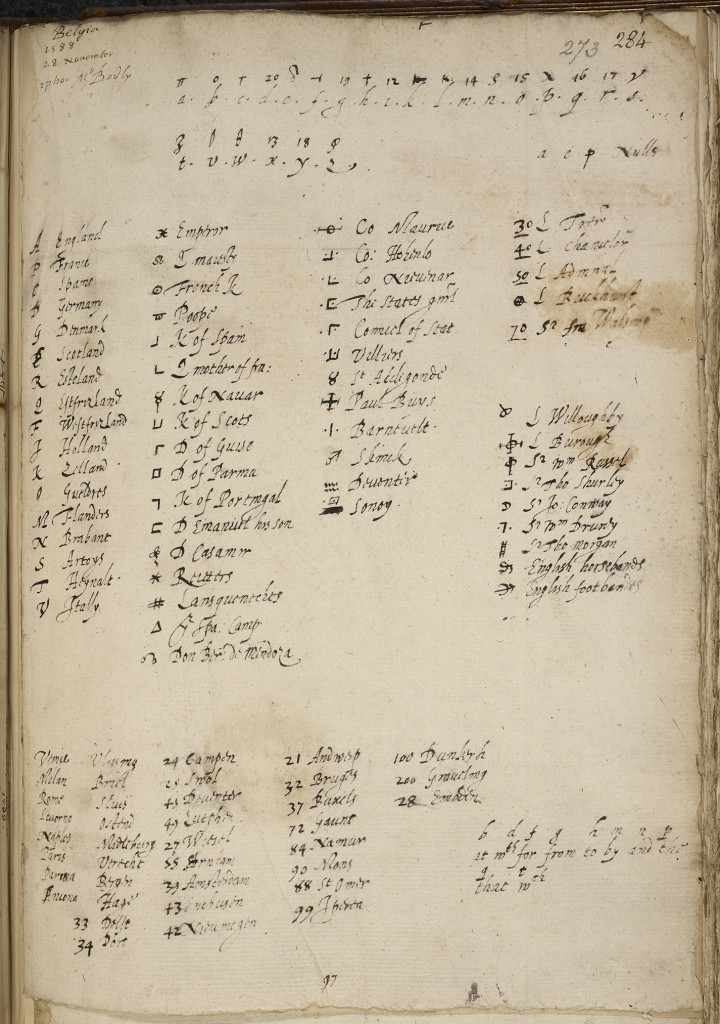*This is the second in a series of 6 posts from Dr Robyn Adams, one the recipients of the [DM2E Open Humanities Awards](http://openhumanitiesawards.org/).*

This post gives a little background to the project that will generate [data visualizations from the correspondence of Thomas Bodley](https://blog.okfn.org/files/2013/05/Thomas_Bodley-192×300.jpg). I hope to reveal the context of what Bodley was up to on the continent, and also get a little bit closer to the types of intelligence, news and reports he sent. This lies at the heart of the task to link the data embedded within the project: whether and how the contents of the letters can be reconstructed visually to create networks and patterns of information.
Thomas Bodley was nominated as the replacement for the outgoing English ambassador, and arrived in the Low Countries (now known as the Netherlands) in December 1588. His main role was to sit on the Dutch Council of State as one of two English representatives that Elizabeth I was permitted to appoint as part of the [Treaty of Nonsuch of 1585](http://en.wikipedia.org/wiki/Treaty_of_Nonsuch). His brief was to represent English interests in the conflict against the Spanish and Catholic threats against England. He spent the next 9 years in The Hague where the Council was situated, constructing a solid network of correspondence with contacts back home in England and across northern Europe. He made journeys around the Low Countries from time to time, and only made the journey back home to England rarely.
His letters are typically a mix of military and political information: discussing the allegiances of Elizabeth’s fellow European sovereigns as to whether they would join the fight against Spain, charting the efforts of the Spanish to recapture towns that had rejected Spanish rule, and itemizing in scrupulous detail the movements of English, Dutch and enemy troops across the region. He was particularly punctilious in enumerating the quantity of troops, victuals and horses possessed by the enemy or promised by allies: crucial information for the English government when conducting a military campaign from afar.
Bodley was careful to report intelligence and news – even that which was unverified – in order that his political masters back home had the most up-to-date information to hand. A key practice of his was to copy out intercepted letters of intelligence and enclose them within his correspondence. This kind of letter-writing activity demanded substantial resources. Bodley had a secretary and aide, [George Gilpin](http://www.oxforddnb.com.libproxy.ucl.ac.uk/view/article/10758), who was a veteran of English diplomatic service which had grown out of his mercantile career. Writing and copying out letters together, they would have required copious amounts of paper, ink, quills for writing, knives to shape, cut and sharpen the quills, sand for blotting the ink, and many more accoutrements now lost to the modern experience of handwriting. The archival remains of Bodley’s correspondence during his embassy to the Low Countries suggest that he was sending a letter nearly every day. Many of these letters are 5 or more folio pages long, and a huge number exist in 2 or more copies: these were dedicated letter-writing professionals.
Most diplomats of the period were careful to keep a copy of sent correspondence for reference and security – letters could easily get lost through interception and bad weather. The first few lines of letters in this period were often given over to making reference to letters already received, and alerting the reader to any letters previously sent. The method of postage was a royal service which brought the post between the English court and her continental ambassadors. Like the post today, this service was subject to delays, reliant as it was on good weather for a channel crossing, and well-rested horses being available for transport between towns.
When he departed for the Low Countries, Bodley was handed a [cipher](http://www.livesandletters.ac.uk/bodley/images.html) so that if his letters were intercepted, they would be difficult to read. His patron admitted that the cipher was [‘not verie curiouslie made for avoidinge of trowble to us both but yet sufficient to serve our purpose’.](http://cell.livesandletters.ac.uk/Bodley/transcript.php?fname=xml//1590//DCB_0987.xml) (Most ciphers in this period were endlessly recycled and eminently breakable, and many European rulers had their own ‘black chambers’ staffed by code-breakers).
Yet the majority of his letters remain un-ciphered. Considering the sensitivity of the information contained in his diplomatic dispatches, this is surprising. However, the areas of the letters called the salutation (or opening line), and valediction (or closing line), often make reference to figures appointed to carry the letters personally between England and the Low Countries. These figures were called ‘bearers’, and it was their job to ensure that the letters were not intercepted or tampered with along their route to the recipient, and that they met with the minimum of delay. Along with an added measure of security, these figures add another facet to the correspondence of the early modern period: accompanying the letter, the bearer was frequently called upon by the recipient to furnish extra information; information which is for the most part now lost.
Thomas Bodley’s bearers – early modern ‘frequent flyers’, judging by their numerous cross-channel journeys – form interesting and ancillary nodes of this correspondence project and the task at hand to visualize the networks of information within. They are the human, often shadowy presence behind much of the correspondence, tracing and marking the physical route between recipient and correspondent in England and the Low Countries. Mentioned in the correspondence, and an active agent participating in the successful process and completion of the correspondence, they remain relatively un-credited. One of the purposes of the *Joined Up Early Modern Diplomacy Project* is to rehabilitate and recover information about these people (most often they are men). The exciting job at hand is to develop a means to visualize the networks of agents and correspondents in relation to their role within the letter network: can we work out a way of representing the bearer so their agency is visible despite not putting pen to paper?

Comments are closed.